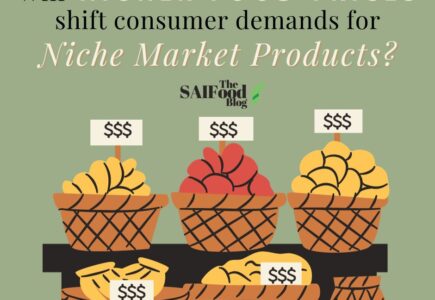Changes in holiday meals and dining out
The seemingly relentless increase in food prices is having many effects on food purchases. In October 2023, Canadian consumers expressed statements saying they would be changing their Thanksgiving purchases due to the dramatic rise in the price of some of their holiday staples. Double digit increases in items such as turkeys (18%), squash (63%), sweet potatoes (40%), green beans (11%) and apples (9%), convinced consumers to shop for less expensive holiday meal alternatives. With Christmas and New Year celebrations just weeks away, shifts in these meals should also be anticipated.
Higher food prices and increased labour costs are but two factors that contribute to rises in the cost of dining out. University of Dalhousie professor, Sylvain Charlebois notes that a recent study conducted by his food lab team found that 51% of Canadian restaurants are operating at a loss. This study additionally found that 30% of Canadians were dissatisfied with their restaurant dining experiences, predominantly due to higher priced menus.
Cost of niche market labelling
Many food companies seek to gain competitive advantages by placing logos on their products, albeit at a higher price. Over the past decade, plant-based meat products have been touted as a sustainable alternative to meat protein. However, declining consumer appetites for plant-based meat products have resulted in several chains discontinuing to carry these products and one article calling plant-based products a “flop”. The price of plant-based products have been consistently higher than actual meat products, with one estimate that utilized Nielsen data in the USA finding “that, on average, plant-based meat is 2x as expensive as beef, more than 4x as expensive as chicken, and more than 3x as expensive as pork per pound.”
Another niche market label is the Non-GMO Project label. This label is applied as long as firms pay the requisite fee. The CFIA confirms that this logo is applied without any investigation and that in many instances there are no GM alternative products, meaning that the ‘Non-GMO’ label is meaningless. The images below confirm the label is applied to any firm that pays the fee to apply the logo. Salt doesn’t even have protein in it, so there is absolutely no way for it to be non-GMO. The same applies to oil products, not to mention there are no GM olives! There are no GM grapes either. The Non-GMO Project openly admits that consumers have expressed a preference to pay at least 10% more for items with their logo.

While consumers may not be aware of the cost increases when a firm pays the fee to add the Non-GMO Project logo, it automatically results in an increase in the price of the product. A robust American academic study on the cost increase of non-GMO labelled products found that the price increase ranged from 10% to 62%. The research article found the following, “[t]he average price premiums for non-GM salad and cooking oils, tortilla chips, breakfast cereals, and ice cream over their conventional counterparts were 61.8%, 24.3%, 26.3%, and 9.8%, respectively.”
In Canada, the organic industry admits that organic labelled food products on average cost 47% more than conventional products. The higher price for organic labelled products is due to lower yields of organic crops, which can range as high as 71% lower than conventional yields. Examples of lower yields are: strawberries and tomatoes 61%, grapes and carrots 49% and apples and coffee 25%.
Will price shift demand?
With interest rates rising, so too are monthly mortgage payments. Households are experiencing less disposable income and are therefore faced with making increasingly more conscious spending decisions. One significant area of saving will be for consumers to return to purchasing conventional food products, foregoing the extremely more expensive niche labelled products.

